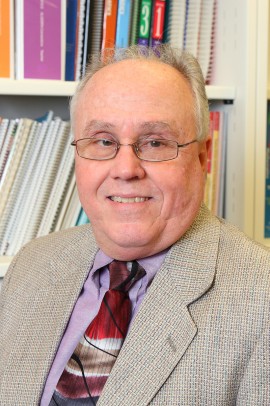Teaching next generation of science learners

James Pellegrino, distinguished professor of psychology and education and co-director of the Learning Sciences Research Institute.
In the April 19 issue of the journal Science, James Pellegrino, distinguished professor of psychology and education and co-director of the University of Illinois at Chicago Learning Sciences Research Institute, says the new changes provide educators a chance to redefine what it means to be a science learner in the 21st century.
The Next Generation Science Standards aim to make high school graduates more competitive in today’s global economy. Released this month, the science teaching standards — like the Common Core State Standards for math and reading — emphasize depth over breadth.
With the goal in part to cultivate critical thinkers, changing science education is an “extraordinary opportunity,” says Pellegrino, a leading expert in learning and assessment, who has produced influential research on educational policy and practice for over 30 years.
Pellegrino offers several reasons why the new standards, which could be adopted as early as 2014, bring opportunities and challenges.
Developed by education leaders representing 26 states, the new standards focus on science skills and content that K-12 students are expected to learn and will need for success in college and in life. Instruction and testing will challenge students’ ability to combine conceptual knowledge with logic to explain scientific results.
The theory is that the new content will produce a larger and more talented pool of workers to help U.S. businesses compete in a high-tech global economy.
To ease the transition — science standards were last revised 15 years ago — Pellegrino says it’s important to give teachers the necessary time, support, curricula, and assessment tools to find new ways of teaching and scoring student performance.
“Assessment is a key element in the process of educational change and improvement,” he said. “Done well, it can signify what we want students to know and be able to do, and help educators create learning environments that support attainment of those objectives.”
States should conduct rigorous assessment research, in collaboration with teachers and curriculum specialists, before implementing the new standards, he said. Educators should learn from other successful, large-scale assessments.
“The greatest danger is to rush,” he said. “We don’t have to rush.”
No federal funds were used to create the standards, and the decision to adopt them will be left to the states.
UIC ranks among the nation’s leading research universities and is Chicago’s largest university with 27,500 students, 12,000 faculty and staff, 15 colleges and the state’s major public medical center. A hallmark of the campus is the Great Cities Commitment, through which UIC faculty, students and staff engage with community, corporate, foundation and government partners in hundreds of programs to improve the quality of life in metropolitan areas around the world.
